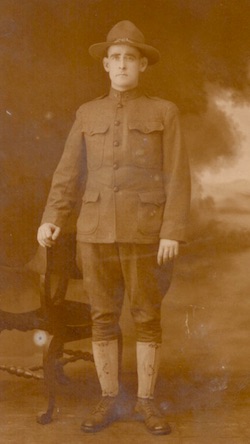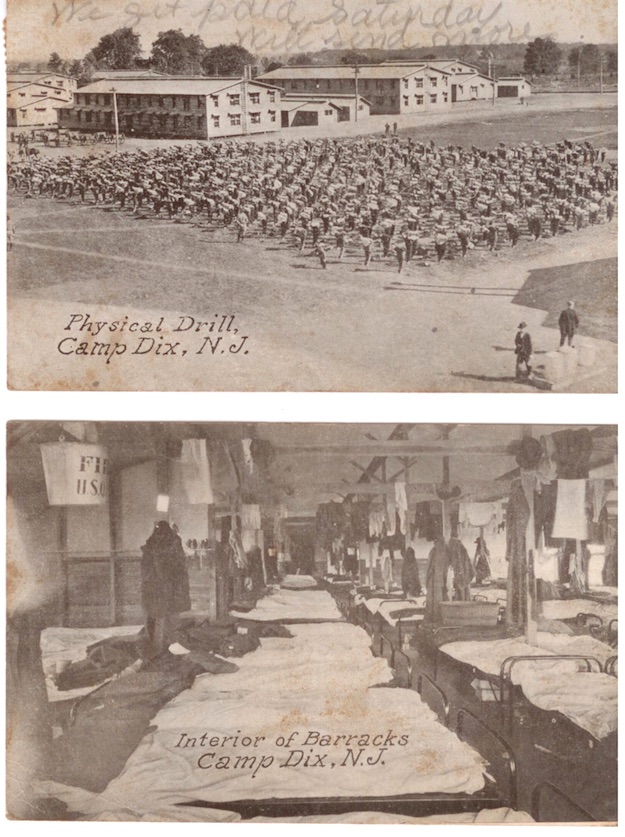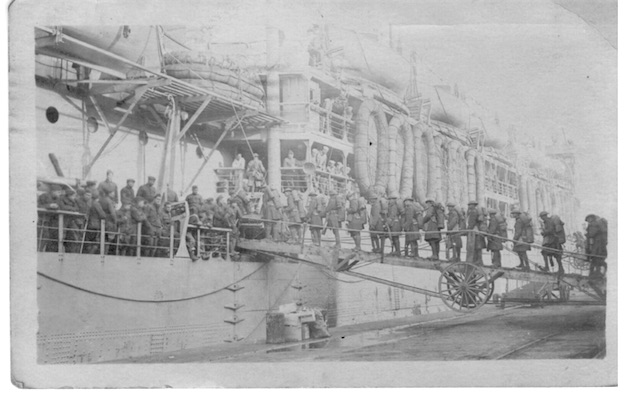‘I’m all right. Don’t worry about me’ – in letters, WWI soldier details danger from combat, disease

A soldier’s letters sent home, saved since WWI
By Catherine Cooper, Orleans County Historian
Illuminating Orleans, Vol. 1, No. 28
MEDINA – He was an ordinary guy.
Born in Holley in 1887, he attended Holley schools. His family had moved to Medina by 1908. His father, who served in the Civil War and survived Libby and Andersonville prisons, owned a quarry.

Daniel F. Burns, WWI soldier
At the time of the 1915 Census, Daniel F. Burns, then aged 26, lived at home at 110 State St., with his mother, sister and niece. He was a stone contractor. He probably gave little thought to news of events a continent away which were to change his life.
On 2 April 1917, President Woodrow Wilson appeared before a joint session of Congress to ask for a declaration of war against Germany. The Selective Service Act of May 1917 made all resident males between 21 and 30 liable for registration and draft. This was expanded to the ages of 18 and 45 in August 1918.
In 1917, Dan was enlisted in Co. I, 309th Infantry, 78th Division and was sent to Fort Dix, New Jersey for training. He wrote home regularly. His letters were straightforward: he would reassure the family of his well-being, refer to the weather, one or two general sentences, greetings to an aunt and niece. He did not dwell on emotional issues, though in one letter written in early January 1918, he wrote that he was lonesome on returning from Christmas leave at home.
On several occasions, he mentioned that they had not been paid, that their pay had been delayed. His mother sent him money a few times. Later, he sent money home. He mentioned an outbreak of measles which necessitated a three-week quarantine, He worked at the Mess Hall for a short time, an advantageous position as he could secure better rations.
He described a life insurance policy which was available:
“The Government has an insurance. You pay $5.70 a month on $10,000. If anything happens to you, your people get $56 a month for twenty years.”
He mentioned meeting people that he knew:
Letter from Camp Dix, not dated, 1918:
“Met the fellow that put in bricks in the road in front of the house in Medina. (State St.)”
Letter from Camp Dix, not dated, 1918:
“Saw Dean Hinckley yesterday. Herbert Housel is in the same Co.”
Letter from Camp Dix, Nov. 26, 1917
“Stanley Pahurch (Pahura) from Holley is here.”
The troops were shipped overseas in May 1918. In an early letter from that time, he wrote:
“I met the Snyder boy from Medina yesterday. He worked at the freight house with Gert….Great many dying with flu in England. Does not seem to be as much of it in France. The fellows all want to get back before the States go dry.”

Postcards showing For Dix, New Jersey, with a capacity of almost 43,000, was one of the largest training camps in the northeast.
There are few letters from the summer of 1918. Co. I, 309th Infantry, 78th Division participated in the Battle of Saint Mihiel which took place from the 12-16 Sept. 1918 and in the Meuse-Argonne offensive which was fought from Sept. 26 – Nov. 11, 1918, when the Armistice was signed. This was the largest and deadliest campaign in US history, a series of final confrontations in the Alsace-Lorraine area of northwest France which helped end the war. Over one million American soldiers participated, 26,277 were killed and 95,786 were wounded, among them Dan Burns.
Dijon, Dec. 4 1918, a letter to his mother:
“I was shot in the arm on the 16th of October at the battle of Grandpre….about half the men I came out with are killed or wounded.
Jan. 21, 1919, a letter to his sister:
“I wrote and told you I was wounded on the 16 October. I was in the hospital about a month. I was shot in the arm. I was very lucky. They lost about 2/3 of the company. Many of the Lockport fellows were killed. I saw George Harmer when he got hit. He did not live long.”
France, May 18, 1919:
“Just a few lines to let you know I am in a hospital about two weeks. I had a lame leg and a little heart trouble.
I have been in France a year; it seems like five.”

Postcard showing soldiers boarding for trip to Europe.
Upon his return to the US in June 1919, he was hospitalized at Camp Stuart Embarkation Hospital in New Port News, Va. and later transferred to the Fort McHenry base hospital in Baltimore, Md.
He returned home to Medina and was employed by the New York State Dept. of Canals. He did not speak about his experiences. Family lore recalls that:
“He was never the same. He was always cold. He just wanted to be warm and have good food.”
Like so many of the other soldiers who returned, he suffered from the lingering effects of his harrowing wartime experiences. Depression, insomnia, nightmares were common, many returned soldiers were unable to cope, and little assistance was available. As we observe Veterans Day, we recognize those who perished as well as the physically injured and the inwardly scarred.
He died in 1956 and is buried at St. Mary’s Cemetery, Medina.
















































































